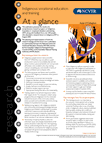Description
This publication presents the results of a comprehensive research program on Indigenous Australians in vocational education and training (VET), along with feedback from over 200 people who attended the NCVER Research Forum on Indigenous VET in August 2005. The planning and implementation of the research strategy and the forum were undertaken in a partnership between the National Centre for Vocational Education Research and the former Australian Indigenous Training Advisory Council of the Australian National Training Authority Board.
Summary
About the research
This publication presents the results of a comprehensive research program on Indigenous Australians in vocational education and training (VET), along with feedback from over 200 people who attended a research forum on Indigenous VET in August 2005.
The planning and implementation of both the research strategy and the forum were undertaken in a partnership between the National Centre for Vocational Education Research (NCVER) and the former Australian Indigenous Training Advisory Council (AITAC) of the Australian National Training Authority (ANTA) Board.
Key messages from the research
- Indigenous people receive various benefits from VET.While they may not achieve a paid employment outcome immediately, they almost always receive a personal benefit, such as improved self-esteem. Even students who stop training without completing any units benefit in terms of gaining confidence and workplace skills.
- The following seven key factors lead to positive outcomes for Indigenous Australians when present all of the time.
1 Community involvement and ownership
2 Indigenous identities, cultures, knowledge and values
3 Working in true partnerships
4 Flexibility in course design, content and delivery
5 Quality staff and committed advocacy
6 Extensive student support services
7 Appropriate funding that allows for sustainability.
- Training needs to be 'demand responsive' rather than 'supply driven'. For example, in desert areas, programs that are integrated into the social and cultural framework of the community achieve more successful and sustainable outcomes (Young, Schaber & Guenther, forthcoming).
- Building strong rapport with Indigenous students and communities, and sharing knowledge between Indigenous and Western cultures, leads to positive outcomes. A responsive and culturally-affirming learning environment is created by negotiating all aspects of training with students and community and family members in an informal, collaborative manner.
- Partnerships should be flexible to allow for unforeseen issues and changes. Expectations of all parties should be made clear from the beginning, with an understanding that the term 'governance' holds different connotations for Indigenous people, compared with government perspectives (Blair & Hanlen, forthcoming).
- More Indigenous staff are required in order to keep pace with Indigenous participation in VET.There is a particular demand for young and female staff, as well as those able to work in regional and remote locations (Kemmis et al., forthcoming).
- Successful outcomes are achieved where extensive support is available, such as literacy and numeracy programs, mentoring, one-onone tutoring (McGlusky & Thaker, forthcoming) and wider support to gain and maintain employment (Callan & Gardner 2005).
- Funding must be flexible to allow long-term planning and accommodate the above factors.
Key messages from forum participants
- The training process is as important as the outcome. Social aspects such as having fun and building relationships are valued outcomes.Training is also a way of building pride in Indigenous culture, sharing traditional learning styles, creating role models and fostering motivation and resilience.Whole-of-life support is important before, during and after training.
- Forum participants suggested actions that should be taken in relation to each of the six priority areas identified in Partners in a learning culture:The way forward (ANTA 2005), as summarised at the end of this publication.
Download
Related items
Successive Australian governments over the last 20 years have focused on providing employment progra… Show more
